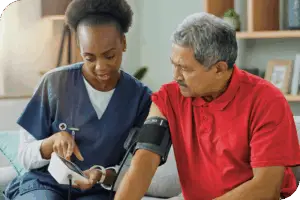Separating Fact from Fiction
Jeremy Fejfar, PharmD
The national spotlight on opioid use has initiated an important dialogue on what the opioid epidemic means for patients and the concerns providers may have in de-prescribing opioids while continuing to provide compassionate care for patients’ pain.
See Companion Articles:
This article highlights common misconceptions related to opioids and looks at some of the alternatives available to help manage pain. It is important for providers and patients to work together to lower the number of opioids prescribed. The first step in doing so is understanding the problem and identifying possible solutions.
Myth
Only addicts become addicted.
Addiction is not easily defined and has a negative image. Many people still view addiction as a character flaw. However, looking at how opioids effect the body can help patients understand why every opioid prescription is important. Opioids cause a number of physiologic changes including the development of tolerance and dependence.
Fact:
Tolerance and dependence will both occur over time, even if addictive behaviors do not.1
Tolerance is what occurs when the previous dose no longer provides the same effect as it initially did, meaning more opioids are needed to achieve the same benefit as before. Dependence is associated with the negative symptoms which occur when opioids are eliminated from the body after regular use.
The absence of addictive behaviors does not indicate how opioids are impacting the body. It is important to consider the bigger picture. The safety concerns related to opioids go beyond addiction and illegal drug use.
Myth
If a patient has a prescription for opioids or has had long-term treatment with opioids, there is a low risk for overdose.
Fact:
In 2016, opioids obtained through a prescription were involved in more than 40 percent of opioid overdose deaths. Overdose deaths were highest between the ages of 25 and 54.2
It is a misconception that an individual is not at risk for overdose if they have been taking prescribed opioids for a long time and due to a legitimate need for pain control.
Patients with legal prescriptions for opioids can be at an increased risk for overdose without being at an increased risk for addiction. These risks increase with age, duration of opioids use and interactions with other medications. Drug interactions are especially risky with benzodiazepines such as alprazolam, lorazepam, etc.
Other conditions that increase risk of overdose are also often overlooked. These illnesses include respiratory conditions (COPD, asthma, sleep apnea, etc.), psychiatric conditions (including depression) and others.3 Helping patients understand why this matters for them individually can put these statistics into perspective.
Myth
Only people taking opioids long term need to worry about tolerance, dependence and addiction.
Fact:
Tolerance and psychological dependence to opioids can begin within days.4, 5
Patients and prescribers alike are sometimes surprised at how quickly our bodies begin to adapt to opioids.4 The physical changes leading to tolerance and the speed it occurs varies from patient to patient.
The body begins to adapt to opioids with the first dose.4 Though it may take time for an individual to notice that tolerance has developed, tolerance increases with ongoing use. It is important for prescribers and patients to closely monitor opioid dispensing. Helping patients understand how to spot the signs of tolerance and dependence will help characterize the impact of opioid use.
Myth
In the emergency department, opioids are the fastest and most effective way to manage pain.
Fact:
Alternatives to opioids may adequately control a patient’s pain in emergency departments.
Opioids may be the right choice in an acute setting, which is where the clinical judgment of a physician plays a crucial role. The most common reason patients go to the emergency department is pain.6
In a 2007 study of emergency department practices, 70 percent of subjects requested a pain medication and 86 percent of those received one.7
St. Joseph’s Health, Paterson, New Jersey launched a program to manage patients’ pain in the emergency department without utilizing opioids.8 The results from the Alternatives to Opiates Program (ALTO) have not been published, but St. Joseph’s is reporting a 50 percent decrease in opioid use while still providing adequate pain relief to 75 percent of patients.
The program defined alternatives based on the condition or nature of the pain. Some of the alternatives included some over-the-counter (OTC) medications. Other studies support that alternatives, such as ibuprofen plus acetaminophen (taken at the same time, not on an alternating schedule) and condition-targeted pharmacotherapies, may provide equivalent or better relief than opioids in the emergency department, although more study is needed.9, 10, 11
Myth
Opioids are the best option for managing chronic pain.
Fact:
There is not enough evidence to say opioids are beneficial long-term.13, 14, 15
While opioids have a legitimate place in therapy with chronic cancer-related pain, end-of-life care, acute care and others, opioids are not recommended for long-term non-cancer related pain management.12 Guidelines recommend using non-opioid medications and alternative therapies to their fullest benefit before resorting to opioids for these patients with chronic pain. While the risk to patient safety is an important factor when considering opioid therapy, there are other reasons why opioids may not be the right choice for managing chronic pain.
Sufficient evidence that opioids are beneficial at managing pain long-term has not been established. In fact, one study demonstrated that some OTC drugs had a more significant impact on pain intensity after a year than opioids did.16 While more research is needed for alternatives to opioids in addressing chronic pain, tailoring treatment to a patient’s individual condition can help guide physicians to treatment options.17, 18
Myth
If a patient has been on an opioid for a long time, it’s better not to change their therapy.
Fact:
Slowly eliminating opioids can be difficult for patients and may be met with fear.
Opioids are often not the most powerful nor best option for managing pain. If possible, treatment should be targeted towards addressing the primary cause of pain. Studies have shown as many as one third of Americans are in acute or chronic pain at any given time.19 Unfortunately, finding and eliminating the cause of the pain is often a diagnostic challenge.
The prospect of stopping opioids can be frightening to patients who have experienced long-term opioid therapy. It is essential that providers and patients communicate clearly about discontinuing opioid therapy.20, 21
Patient concerns may include –
- Not understanding their unique risk related to opioids
- Fear of side effects or worsening pain
- Fear of feeling abandoned by their provider
- Fear of not having any control or say in their therapy
While more research is needed, studies support that reducing or discontinuing long-term opioids may improve patient pain intensity, quality of life and level of function. Good communication is an essential part of helping patients move off opioid therapy.20-23
Myth
Opioids are the only option to manage pain that works.
Fact:
It may take combining non-medication therapies and medication to treat the cause of chronic pain.
Whether pain is acute or chronic, there are alternatives to opioids which can help to alleviate pain.8, 9, 17, 18, 23 Alternatives to opioids take many forms and go beyond prescription solutions.
Non-medication options include hot and cold therapies, physical therapy, massage therapy, acupuncture, strength training, transcutaneous electrical nerve stimulation (TENS), improving sleep hygiene, relaxation techniques or meditation and cognitive behavioral therapy, to name a few.23 Patients and providers can work together to find the most effective approach.
Some non-opioid medications include topical creams or patches, acetaminophen, nonsteroidal anti-inflammatory drugs (NSAIDs), anticonvulsants, antidepressants and muscle relaxants.18 One mainstay in managing pain is NSAIDs, such as ibuprofen, which have shown to be effective in managing pain for a variety of conditions. NSAIDs, however, have a ceiling effect. After reaching a certain dose, the level of benefit no longer increases but the risk of side effects does.24 Anticonvulsants, such as gabapentin, pregabalin and topiramate, are beneficial for some nerve pains.23 Antidepressants, such as duloxetine, nortriptyline, fluoxetine and others, may have analgesic effects.18, 25
- Munir AM, Enany N, Zhang JM. Nonopioid analgesics. Anesthesiol Clin. 2007;25(4):761-774.
- Seth P, Scholl L, Rudd RA, Bacon S. Overdose deaths involving opioids, cocaine, and psychostimulants – United States, 2015-2016. MMWR Morb Mortal Wkly Rep. 2018;67(12);349-358.
- Webster LR. Risk factors for opioid-use disorder and overdose. Anesth Analg. 2017;125(5):174-1748.
- Baily CP, Connor M. Opioids: cellular mechanisms of tolerance and physical dependence. Curr Opin Pharmacol. 2005;5(1):60-68.
- Dang VC, MacDonald JC. Mechanisms of rapid opioid receptor desensitization, resensitization and tolerance in brain neurons. Br J Pharmacol. 2012;165(6):1704-1716.
- Cordell WH, Keense KK, Biles BK, Jones JB, Jones JH, Brizendine EJ. The high prevalence of pain in emergency medical care. Am J Emerg Med. 2002;20(3):165-169.
- Todd KH, Ducharme J, Choiniere M, Crandall CD, Fosnocht DE, Homel P, Tanabe P. Pain in the emergency department: results of the Pain and Emergency Medicine Initiative (PEMI) multicenter study. J Pain. 2007;8(6):460-466.
- St. Joseph’s Health. St. Joseph’s ALTO – alternatives to opiates: reducing the risk of opioid dependency and overdose.
- Chan JL, Frampton C. Oral non‐steroidal anti‐inflammatory drugs versus other oral analgesic agents for acute soft tissue injury. Cochrane Database Syst Rev. 2015;7:CD007789.
- Todd KH. A review of current and emerging approaches to pain management in the emergency department. Pain Ther. 2017;6(2):193-202.
- Chang AK, Bijur PE, Esses D, Barnaby DP, Baer J. Effect of a single dose of oral opioid and nonopioid analgesics on acute extremity pain in the emergency department: a randomized clinical trial. JAMA. 2017;318(17):1661-1667.
- Centers for Disease Control and Prevention Public Health Service US Department of Health and Human Services. Guideline for prescribing opioids in chronic pain. J Pain Palliat Care Pharmacother. 2016;30(2):138-40.
- Hauser W, Shug S, Furlan AD. The opioid epidemic and national guidelines for opioid therapy for chronic noncancer pain: a perspective from different continents. Pain Rep. 2017;2(3):e599.
- Els C, Jackson TD, Kunyk D, et al. Adverse events associated with medium- and long-term use of opioids for chronic non-cancer pain: an overview of Cochrane reviews. Cochrane Database Syst Rev. 2017;10:CD012509.
- Chou R, Turner JA, Devine EB, et al. The effectiveness and risks of long-term opioid therapy for chronic pain: a systematic review for a National Institutes of Health Pathways to Prevention Workshop. Am Intern Med. 2015;162:276-286.
- Krebs EE, Gravely A, Nugent S, Jensen AC, et al. Effect of opioids vs nonopioid medications on pain-related function in patients with chronic back pain or hip or knee osteoarthritis pain: the SPACE randomized clinical trial. JAMA. 2018;319(9):872-882.
- Kaye AD, Cornett EM, Hart B, et al. Novel pharmacological nonopioid therapies in chronic pain. Curr Pain Headache Rep. 2018;22(4):31.
- Nicol AL, Hurely RW, Benzon HT. Alternatives to opioids in the pharmacologic management of chronic pain syndromes: a narrative review of randomized, controlled, and blinded clinical trials. Anesth Analg. 2017;125(5):1682-1703.
- Wilson-Poe AR, Moron JA. The dynamic interaction between pain and opioid misuse. Br J Pharmacol. 2018;5(14):2770-2777.
- Matthias MS, Johnson NL, Shields CG, et al. “I’m not gonna pull the rug out from under you”: patient-provider communication about opioid tapering. J Pain. 2017;18(11):1365-1373.
- Frank JW, Levy C, Matlock DD, et al. Patients’ perspectives on tapering of chronic opioid therapy: a qualitative study. Pain Med. 2016;17(10):1838-1847.
- Frank JW, Lovejoy TI, Becker WC, et al. Patient outcomes in dose reduction or discontinuation of long-term opioid therapy: a systematic review. Ann Intern Med. 2017;167(3):181-191.
- Shipton EA, Shipton EE, Shipton AJ. A review of the opioid epidemic: what do we do about it? Pain Ther. 2018;7:23-36.
- Goldstein JF. Adjuncts to opioid therapy. J Am Osteopath Assoc. 2002;102(3):S15-S20.
- Dharmshaktu P, Tayal V, Kalra BS. Efficacy of antidepressants as analgesics: a review. J Clin Pharmacol. 2012;52(1):6-17.



